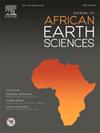埃及Wadi El Natrun地区Nabaa Al Hammara地区地下水含水层圈定的水文地球物理调查
IF 2.2
4区 地球科学
Q2 GEOSCIENCES, MULTIDISCIPLINARY
引用次数: 0
摘要
本研究结合地球物理和水化学方法,对研究区内的淡水饱和区和水质进行了制图和识别。总共部署了24个垂直电测深(VES)站,以确定关键的含水层参数,如厚度和真实电阻率。此外,还对7个时域电磁站(TEM)进行了调查,以证实VES的结果。对分布在研究区内的7口井进行了测井分析。对7个水样进行了水化学分析,以评估阳离子、阴离子、水类型和水质比率。综合解释揭示了三个不同深度的不同含水层的存在。第一个含水层位于60 ~ 70 m之间,其电阻率值为11.5 ~ 68 Ω-meters,具有淡水性质。第二个含水层位于100-115 m深度,电阻率在6.9 - 52 Ω-meters之间。第三层为深部含水层,深度180 ~ 200 m,厚度155 ~ 203 m,电阻率值为6.5 ~ 62 Ω-meters。这些含水层显示出高潜力,透过率(Tp)为851 m2/天,电导率值在13.5 ~ 14.9 m/天之间。水化学分析表明,主要水类型为氯化钠(NaCl)。本文章由计算机程序翻译,如有差异,请以英文原文为准。
Hydrogeophysical investigation for delineating groundwater aquifers in the Nabaa Al Hammara area, Wadi El Natrun, Egypt
This study integrates geophysical and hydrochemical methods to map and identify freshwater-saturated zones and water quality within the study area. A total of twenty-four Vertical Electrical Sounding (VES) stations were deployed to determine key aquifer parameters, such as thickness and true resistivities. Seven Time Domain Electromagnetic (TEM) stations were also surveyed to corroborate the VES results. Well-logging analysis was conducted in seven boreholes distributed across the study area. Hydrochemical analysis of seven water samples was carried out to assess cations, anions, water type, and water quality ratios. The combined interpretation reveals the presence of three distinct aquifers at varying depths. The first aquifer, located between 60 and 70 m, exhibits resistivity values ranging from 11.5 to 68 Ω-meters and is characterized by freshwater quality. The second aquifer is found at depths of 100–115 m, with resistivities between 6.9 and 52 Ω-meters. The third, or deep aquifer, lies at depths of 180–200 m, with a 155–203 m thickness and resistivity values ranging from 6.5 to 62 Ω-meters. These aquifers show high potential, with a transmissivity (Tp) of 851 m2/day and conductivity values between 13.5 and 14.9 m/day. Hydrochemical analysis reveals that sodium chloride (NaCl) is the dominant water type.
求助全文
通过发布文献求助,成功后即可免费获取论文全文。
去求助
来源期刊

Journal of African Earth Sciences
地学-地球科学综合
CiteScore
4.70
自引率
4.30%
发文量
240
审稿时长
12 months
期刊介绍:
The Journal of African Earth Sciences sees itself as the prime geological journal for all aspects of the Earth Sciences about the African plate. Papers dealing with peripheral areas are welcome if they demonstrate a tight link with Africa.
The Journal publishes high quality, peer-reviewed scientific papers. It is devoted primarily to research papers but short communications relating to new developments of broad interest, reviews and book reviews will also be considered. Papers must have international appeal and should present work of more regional than local significance and dealing with well identified and justified scientific questions. Specialised technical papers, analytical or exploration reports must be avoided. Papers on applied geology should preferably be linked to such core disciplines and must be addressed to a more general geoscientific audience.
 求助内容:
求助内容: 应助结果提醒方式:
应助结果提醒方式:


